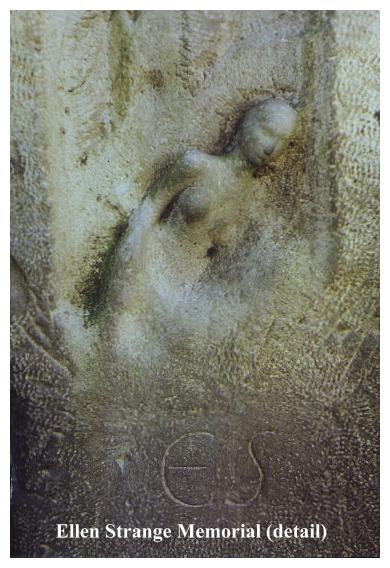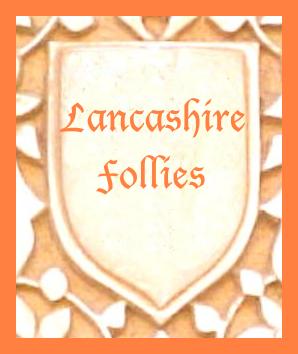5. PEEL MONUMENT HOLCOMBE MOOR
A fine upland ramble on the Pennine Moorlands with sweeping views leading to an excellent prospect tower which is sometimes open for inspection. En route you will encounter the site of an ancient cross, an old well and the scene of a gruesome murder.
Getting there: Follow M66-A56 to Haslingden (west of Rawtenstall) turning left onto the B6214, heading southwest to Helmshore, where there is limited parking opposite the Memorial Gardens. (Note the fine clock tower). Helmshore has all mod cons- inn, post office, shops etc,- as well as an interesting textile museum at Higher Mill. If you wish to cut out the ramble and visit the PEEL MONUMENT direct, Continue along the B6214 on to Ramsbottom and park below the monument near Holcombe Church, where there is a car-park.
Distance: 9 miles approx
Map refs: START OF WALK: SD 782 208 (Sheet 103)
PEEL MONUMENT: SD 777 165 (Sheet 109)
Rating: Walk ** Follies and General Interest **
Our walk to the Peel Monument lies exclusively in the Lancashire part of that area of Pennine uplands which have been loosely dubbed the South Pennines. This is something of a misnomer, for while the area may be geographically much the same as Yorkshire Calderdale just over the hill, ethnically it might as well be in another dimension.
Rossendale, once a leading centre of felt making, still has the largest concentration of slipper and footwear factories in any one place, and until quite recently was an area of grimy chimneys and inreasingly derelict and decaying factories. Behind this industrial blight the area contains some fine walking country, but it is only recently that walks hereabouts have ceased to be the preserve of locals.
Recently, however, this has changed. The tourism 'virus' which so drastically changed the face of 'mucky' Hebden Bridge over in Yorkshire has spread up the Calder Valley to Todmorden and has spilled over into hard- headed Lancashire.
And so we embark upon our ramble, passing first by the site of Sunny Bank Mill where, in 1866, Joseph Porritt began his papermaker's felt business. Porritt, like most Lancashire entrepreneurs, made his mark on the landscape in a substantial way, eventually owning most of the Alden Valley and having mills stretching from one side of the Irwell Valley to the other. For a long time the Porritts dominated the papermaker's felt trade. Inevitably, as time went on, Porritts was swallowed up by larger business concerns. Decline set in, and by 1977 the whole complex had been demolished, an ignominious end to almost a century of local history.
Before reaching Tor Side House, which was Porritt's residence, we turn sharp left by Ivy Lodge to Alden Road, and thence up Stake Lane, passing Dowry Head (the residence of David Trippier M P) on the left. A boggy ascent, made all the more so by the passage of motorcycles, leads upwards to the edge of the moors and Robin Hood's Well, a tiny spring of uncertain origin, and not the only well of that name to be found in the Pennines. Stake Lane was once a part of the old Pilgrims Way to Whalley Abbey, and it is probable that the well was intended as a place of refreshment for weary travellers. Did Robin Hood come here? It seems unlikely. 'Robin Hood' places occur all over the North of England, and it is possible that 'Robin Hood' was but a pseudonym for the Green Man, a very ancient pre-christian deity who would later become a symbol of Saxon resistance to Norman aggression. An old northern expression speaks of having 'Robin Hood's choice'- ie no choice at all! Perhaps this was the only refreshment stop avalable to the traveller crossing the moor - hence the name. When I visited the well it was dry!
Beyond the gate we take to the open moorland, bearing left to a cairn and a curious upright stone in the heather. It bears the letters 'E S' and a curious, badly-weathered sculpture depicting a female figure, with the faint outlines of others. The initials stand for Ellen Strange, and the stone marks the spot where, in 1735, she was most foully murdered.
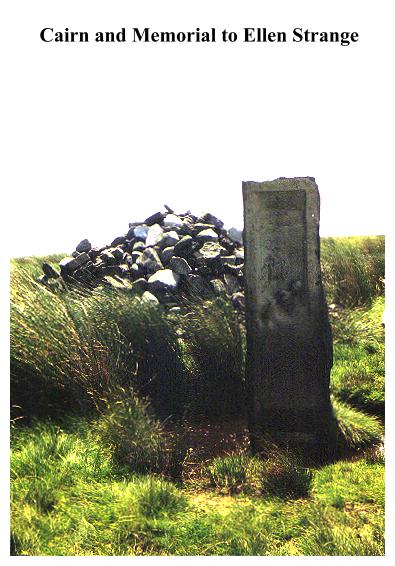
The story goes that Ellen once lived with her parents at Ash Farm, Hawkshaw. She fell in love with a pedlar from Stone Fold named Billy, and one day they set off to Haslingden Fair together. On their way home they called at the White Horse in Helmshore, and were seen to go off home together. It was the last time she was seen alive. Ellen was murdered at this remote spot, where her body was found. The pedlar was arrested and confessed to his guilt. He was executed at Lancaster Castle, and his body afterwards hanged in chains on nearby Bull Hill. The cairn and stone were subsequently erected by sentimental visitors to this sad and lonely spot.
Passing the wall corner we ascend the moor to the boundary of the MOD danger area on Bull Hill. Soldiers are not new hereabouts, sometime during the Civil Wars a band of Royalist soldiers camped up on these moors. From the edge of Bull Hill a well- defined path leads around the perimeter of the training area (marked by posts), descending to the squat monument erected on the site of the Pilgrims Cross.
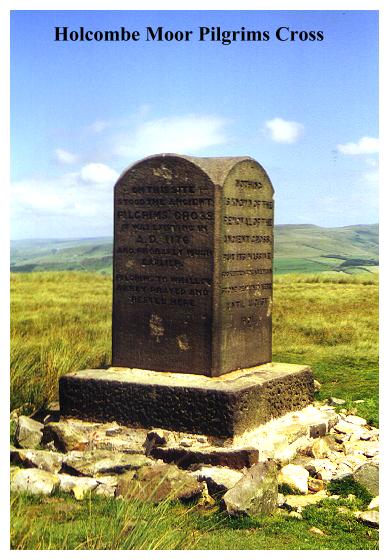
The inscription is self explanatory, even if you have to walk all around this windswept monument to read it:
ON THIS SITE STOOD THE ANCIENT PILGRIMS CROSS. IT WAS EXISTING IN AD 1176 AND PROBABLY MUCH EARLIER. PILGRIMS TO WHALLEY ABBEY PRAYED AND RESTED HERE
IN AD 1176 AND IN AD 1225 THE PILGRIMS CROSS IS NAMED IN CHARTERS OF GIFTS OF LAND IN HOLCOMBE FOREST.IN AD 1662 KING CHARLES II GAVE THIS MANOR TO GENERAL MONK DUKE OF ALBEMARLE FROM WHOM IT HAS DESCENDED TO THE PRESENT LORD OF THE MANOR
THIS MEMORIAL STONE WAS PLACED HERE MAY 24th 1902 BY THE COPYHOLDERS OF THE MANOR AND OTHERS
NOTHING IS KNOWN OF THE REMOVAL OF THE ANCIENT CROSS BUT ITS MASSIVE SOCKET FOUNDATION STONE REMAINED HERE UNTIL AUGUST 1901.
Some old sources refer to the cross as Chattertons or Whowells Cross. The 1902 monument we see now was largely the result of the enthusiasm of the Revd H Dowsett, Vicar of Holcombe, who desired to preserve the memory of the ancient cross, the last vestiges of which had been destroyed by vandals in 1901. One marvels at the tenacity of those turn-of-the century hooligans whose enthusiasm for malicious destruction brought them out to this remote and godforsaken spot.
So we proceed along the heathery moortop to the summit of windblown Harcles Hill, looking back briefly to the now distant Pilgrims Cross, a tiny forlorn dot, lost and lonely in the middle of a vast wasteland. Having said our goodbyes, we descend steeply to the Peel Monument on Holcombe Moor.
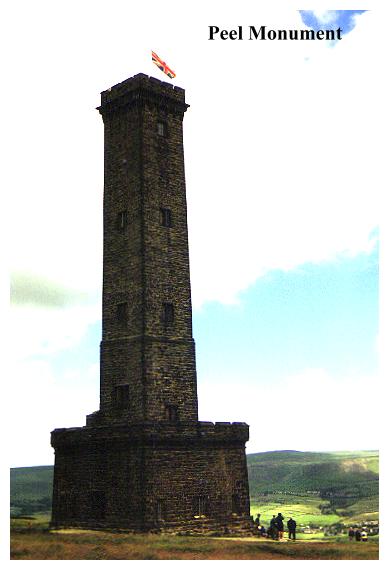
The Peel Monument or Holcombe Moor Tower is one of the great landmarks of East Lancashire. It looks out southwards over the vast urban sprawl of Greater Manchester. Seen from the M66 on a murky day one might be forgiven for thinking it a gaunt chimney, yet here, seen at close quarters, this blackened, castellated tower is obviously no such thing.
A single word over the entrance reveals the reason for its construction. The Peel Tower was erected to the memory of Prime Minister Sir Robert Peel, who, among many other achievements was responsible for founding the police force and repealing the much-hated Corn Laws, which kept the price of bread at an artificially high level. Peel was born in Bury in 1788, where there is a statue to his memory.
The tower was erected at a cost of £1,000 using stone quarried from the hill on which it stands - without the consent of the landowner. The tower was opened on the 9th September 1852, the ceremony being conducted by one Joshua Knowles of Stormer Hill, the proprietor of Tottington Calico Works. A special train was laid on from Salford to Ramsbottom especially for the ceremony, but by the time it arrived all the proceedings were over. The tower was at first managed by a local trust. In 1868 the landowner, the Duke of Buccleuch granted a lease on Holcombe Hill, including the tower, for the sum of 7/6 a year. The trustees were allowed to charge admission to the tower and sell light refreshments.
As with most follies, in the twentieth century the tower has had somewhat of a chequered career. By 1929 it had fallen into a decayed state, and £2,500 had to be raised to replace the rotting wooden staircase with an iron one and to generally renovate the structure. In the 1930s it was run by a local farmer, Percy Vickers, who supplemented the family income by opening up the tower to the public. During the war the tower became a Home Guard lookout post, and by the late 40's it was observed that the iron staircase had become badly rusted. Consequently it was closed to the public in 1947, and in 1949 possession passed from the trustees to Ramsbottom District Council. In 1950 the exterior was repointed, but otherwise the tower was left sealed up. It looked like its days were numbered.
But Lancashire looks after its prospect towers. Like its neighbours at Rivington and Darwen, the Peel Monument has benefitted from the recent restoration boom. With grant assistance, a new concrete staircase was constructed and the tower repointed. After being sealed up for thirty eight years, the tower was once again re-opened to the public in 1985.
The tower is now administered by the Metropolitan Borough of Bury, and is open at weekends and Bank Holidays. When I arrived, a Union Flag was fluttering from the flagstaff, which was visibly bending in the gale force wind. At the foot of the tower a local brass band was in full throat, desperately trying to play whilst at the same time trying to prevent their sheet music from flying over into Yorkshire! The tower itself is an adventure. Inside there is a small cafe which sells booklets and refreshments, but it is the ascent of the tower itself which fascinates. As you ascend the concrete steps, the deep stair-well on your left appears increasingly horrendous! The tower is in fact 128 feet high, and when the final section of the climb suddenly turns into a steel spiral staircase running out over the said stair-well your feeling of vertigo is complete. The tower originally contained 148 steps, but this modern flight, by the reckoning of my daughter, contains 157 steps, 23 of which are spiral.
Outside, on the top of the tower, you feel like you are going to be blown off your feet, but the view is impressive enough, particularly over Greater Manchester. With a little concentration you should be able to make out Hartshead Pike and the transmitter tower in Heaton Park. To the north-west Darwen Tower is visible, as is Belmont, but the area to the west is effectively blocked out by the moorlands. Eastwards there are fine views over Rossendale and across Rochdale to Blackstone Edge, but the high Pennine watersheds effectively rule out any peeking into Yorkshire! The view is really of Manchester, with sweeping views across that great basin to the moorlands of the Dark Peak.
Chilled by the wind, eyes streaming and with the feeling that the tower is actually moving, we descend back to the relative comforts of the caf—. In the base of the tower are a number of inscriptions. One, a painted board, simply tells us about the history of the tower, whilst the other, an inscribed piece of marble placed in the tower during the 1929 restoration quotes from Peel's 1846 resignation speech:
PEEL MONUMENT HOLCOMBE
ERECTED 1852
IN MEMORY OF SIR ROBERT PEEL
"It may be that I shall leave
a name sometimes remembered
with expressions of goodwill
in the abodes of those, whose
lot it is to labour, and to earn
their daily bread with the sweat
of their brow - when they shall
recruit their exhausted strength
with abundant and untaxed food
the sweeter, because it is no
longer leavened with a
sense of injustice."
EXTRACT FROM SPEECH
OF SIR ROBERT PEEL,DELIVERED
IN THE HOUSE OF COMMONS
JANUARY 27th 1846
And so, with this fine sentiment in mind, we take to a well-defined track leading along the hillside above the church, from which we are able to enjoy the fine views over the valley to nearby Ramsbottom. Ramsbottom once had its own magnificent folly in the form of Grant's Tower, a bizarre (and massive) Gothic folly erected by William Grant of Grant Bros, at the time the chief manufacturers of Ramsbottom. The folly was intended to commemorate his father's journey from Morayshire to Lancashire in 1783 in search of work. Unfortunately Grant's Tower was brought down by a great gale in 1943, and Nuttall Hall, the Grant residence, was demolished by the council 1n 1952. The philanthropic Grant brothers, William and Daniel, built mills and cottages all over the valley, frequently importing workers from as far afield as London and Hull. They were immortalised by Dickens in Nicholas Nickleby as benevolent Ned and Charles Cheeryble, although Dickens set them in London. St Andrews Church, which was opened in 1834, is a fine example of their originality and ingenuity. It was originally heated by hot air supplied from Grants Square Mill that came up the hillside through a brick flue almost a quarter of a mile long. The kindly Grants have still left their mark on Ramsbottom, even though most of their more magnificent undertakings are now gone.
Our route eventully leads us past Chatterton Close to a pipe and cascade at the top of Buckden Wood, beyond which lie the spoil heaps of Ironstone Delph- once the site of an early primitive stone/clay furnace. From here the track leads up the hill back to the junction of walls by Robin Hoods Well, at the top of Stake Lane. From here, we head back to Helmshore and the parked car, a fitting end to a fine tramp over lonely windswept moors.
